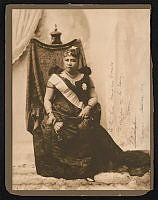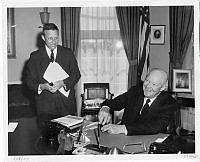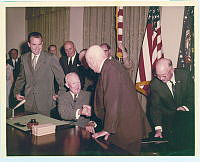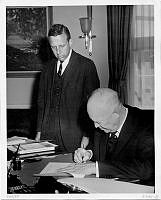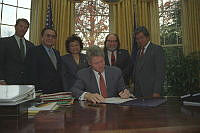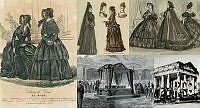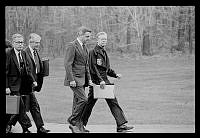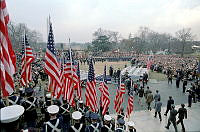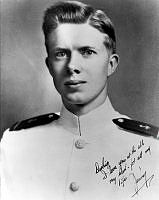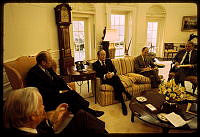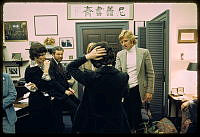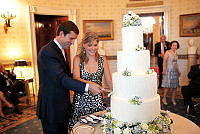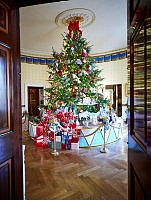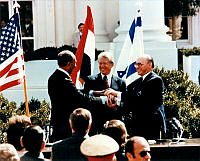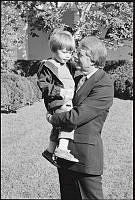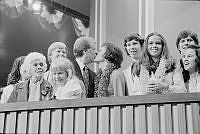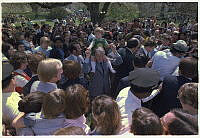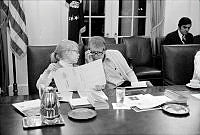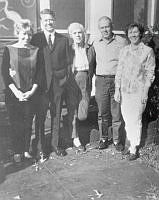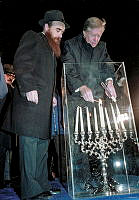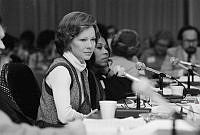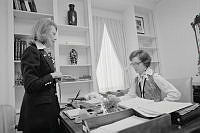Eleanor Roosevelt's "My Day": Ceremonies
Copyright © White House Historical Association. All rights reserved under international copyright conventions. No part of this article may be reproduced or utilized in any form or by any means, electronic or mechanical, including photocopying, recording, or by any information storage and retrieval system, without permission in writing from the publisher. Requests for reprint permissions should be addressed to books@whha.org
Ceremony and ceremonial occasions played vital roles in the Roosevelt White House. Whether presiding over state receptions, entertaining heads of state or hosting diplomatic ceremonies, the Roosevelts used these events and their own personal magnetism to project an image of American democracy that was both substantive and personal.
Many of the ceremonies in the Roosevelt White House followed elaborate rules developed by earlier presidents. For example, protocol for state dinners dictated that the Roosevelts never appear in the East Room until their guests had assembled and arranged themselves in a circle. Once President Franklin D. Roosevelt (FDR) and First Lady Eleanor Roosevelt (ER) arrived escorted by military aides, they stood just inside the door where a military aide presented the guests to them in order of precedence. Then ER and the guests lined up and processed down the hall to the State Dining Room.
The ceremony surrounding state receptions was even more formal. Ten minutes before FDR appeared at such an event, a color guard would enter his private study on the Second Floor of the White House, salute the U.S. flag and the president's flag displayed there and take them to the entrance of the Blue Room where they remained as long as FDR stayed at the reception. When he left, the color guard would repeat the same ceremony in reverse, returning the flags to the private study and marching out. While attending these formal receptions, the Roosevelts would stand under the chandelier in the Blue Room and receive their guests as a military aide announced their names. (Previous presidents had included the members of the Cabinet in the receiving line for these official events. However, FDR, who could not stand for long periods, dispensed with this custom).
Unofficial White House ceremonies were less elaborate in keeping with the Roosevelts' preference for simplicity and brevity. One of ER's "My Day" columns documents one such event, a small ceremony marking the 1938 departure of Head Usher Raymond Muir. Only ER and representatives from "the working staff necessary to run the White House" attended the event where Muir, who was transferring to the State Department, received a wristwatch from his colleagues. The wartime White House wedding of presidential advisor Harry Hopkins and fashion journalist Louise Macy in July 1942 was another quiet affair. Hopkins, who had lived in the White House since 1940, married Macy in FDR's private White House study with the president as best man. The guest list was limited to family, close friends, professional associates and several members of the mansion staff including veteran White House doorman John Mays.
During World War II, public ceremonies took on added symbolic importance as FDR sought to emphasize the difference between democracy and fascism and underscore the Allied commitment to victory. In 1942, for example, he expanded the traditional observance of Flag Day to include the 27 Allied nations fighting the Axis. Allied ambassadors and their nations' flags formed a large "V for Victory" in the State Dining Room as FDR and representatives of the coalition's newest allies, Mexico and the Philippines, signed the "Declaration by the United Nations" on a desk once used by President Abraham Lincoln. Flags also featured in the 1943 White House signing ceremony that created the United Nations Relief and Rehabilitation Administration. On this occasion, the flags of the forty-four participating countries formed a backdrop for the signing ceremony itself. While newsreel cameras recorded the event, each country's delegate approached the signing table, shook hands with FDR, and then sat beside him to sign the agreement.
As much as the Roosevelts valued protocol, they understood that informality could also send a powerful message. For example, when Lord Tweedsmuir, governor general of Canada, and his wife visited the US in 1937, they received a formal White House welcome but dined informally with the Roosevelts on their first night in Washington. When Crown Prince Gustaf Adolf of Sweden fell ill en route to the US for an official visit in 1938, FDR visited him in a New York City hospital, and he and ER entertained Crown Princess Louise at Hyde Park. They also hosted Danish Crown Prince Frederik and Crown Princess Ingrid at Hyde Park during the royal couple's visit in 1939. During World War II, the Roosevelts further streamlined protocol simplifying or eliminating formal entertainments. When King George of Greece and his Prime Minister Emanuel Tsuderos visited the White House in 1942, for example, the Roosevelts combined an official South Lawn welcome with an intimate tea on the South Portico followed by a small state dinner. The Roosevelts further relaxed protocol for such exiled royals as Dutch Princess Juliana and Norwegian Crown Princess Martha who made the White House their home during World War II. Princess Juliana and her family enjoyed a particularly intimate relationship with the Roosevelts. ER's columns describe her lunching informally with FDR in the president's office and with her husband, Prince Bernhard, talking "until late in the night" with the president in his second floor study.
Among the most historic White House ceremonies of the Roosevelt Administration was FDR's unprecedented fourth inauguration held on January 20, 1945—the only presidential inaugural to take place in the White House. With the nation still at war, the president decided to forego the usual Capitol Hill ceremony and Pennsylvania Avenue parade in favor of a church service in the East Room and a simple fifteen-minute ceremony on the South Portico. Flanked by the Roosevelts' eldest son, James, in his Marine uniform, and Chief Justice Harlan Fiske Stone, FDR took the oath of office and delivered one of the shortest inaugural addresses in presidential history—just 551 words. Among those in the smaller-than-usual audience were the Roosevelts' thirteen grandchildren who stood on the steps of the South Portico. ER, who thought the religious service "more nearly met the needs of the day," described the inaugural ceremony as "very solemn and impressive."

Franklin D. Roosevelt giving his third term inaugural speech from balcony.
Library of CongressLess than four months later, family members, President Truman, cabinet officers, military leaders and foreign dignitaries gathered at the White House to bid farewell to FDR who had died suddenly of a cerebral hemorrhage on April 12 in Warm Springs, Georgia. In a stifling East Room stuffed with flowers, Angus Dun, Episcopal Bishop of the Diocese of Washington, and two other clergymen conducted a simple service lasting less than twenty-five minutes. Mourners sang two of FDR's favorite hymns and listened to a scripture reading. At ER's request, Dun closed with a reference to FDR's first inaugural address. "In his first inaugural address the President bore testimony to his own deep faith: 'Let me assert my firm belief that the only thing we have to fear is fear itself.' As that was his first word to us, I am sure he would wish it to be his last; that as we go forward to the tasks in which he led us, we shall go forward without fear of the future, without fear of our allies or our friends, and without fear of our own insufficiency."
FDR's White House funeral service, like all the White House ceremonies of his administration, epitomized the importance the Roosevelts placed on ceremony and protocol. Their adroit use of White House ceremonial coupled with their political sagacity and personal magnetism enabled them to project an image of American democracy that was substantive, powerful, and attractive. Together they exemplified for their contemporaries at home and abroad what it meant to be an American.













